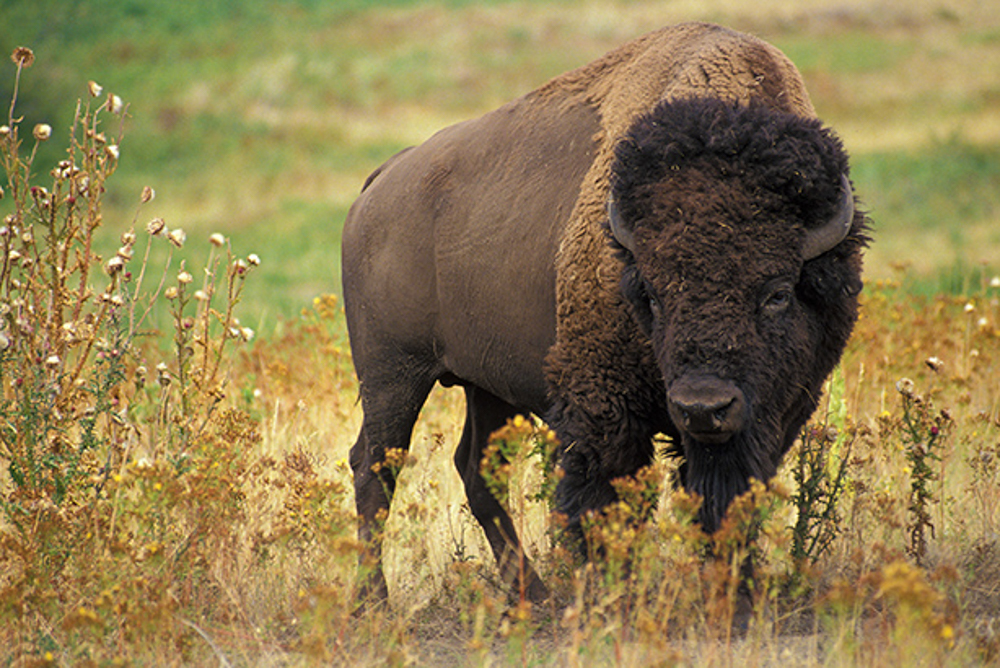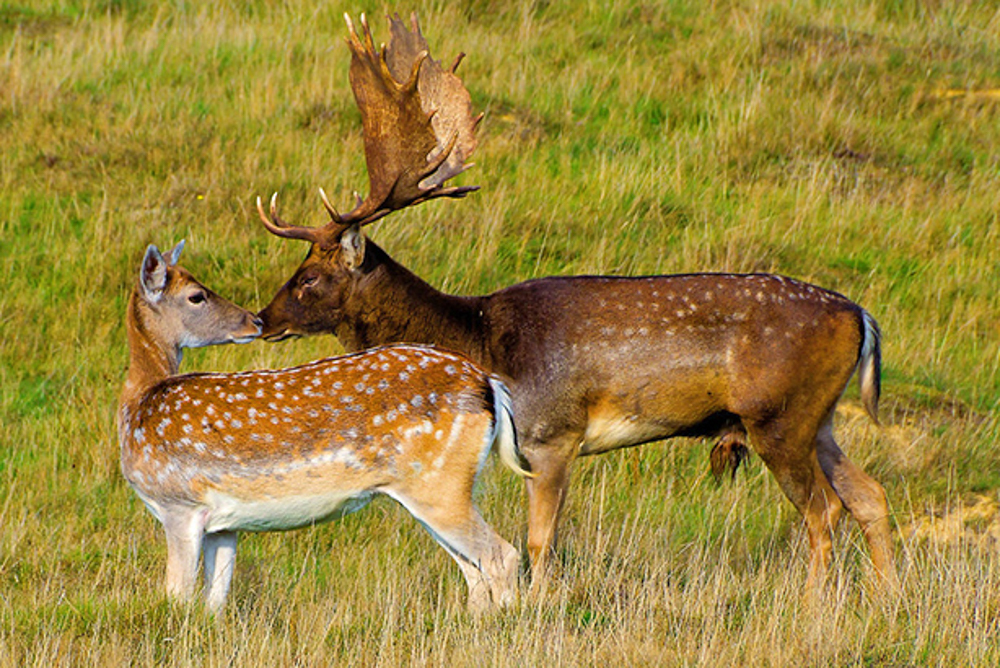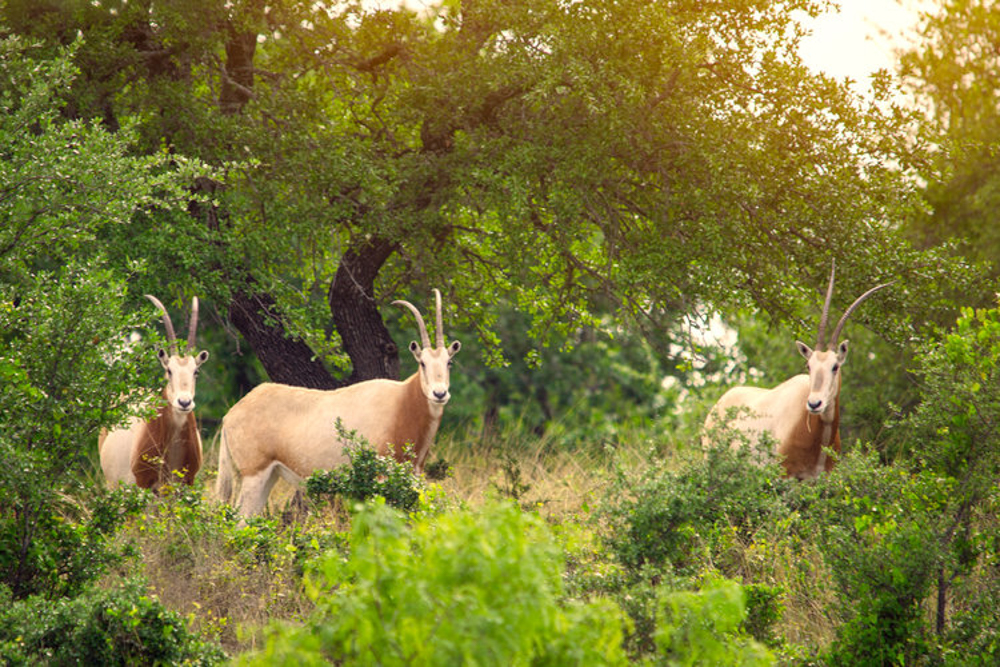Native Wildlife

White-tailed Deer
The most recognizable and hunted of all native wildlife has to be the White-tailed Deer. When the ranch was first acquired in 1997, the deer population was extremely low, almost to the point of being non-existent. This was probably due to improper harvest management, and the lack of available deer food and habitat. In 1998, the ranch planted several deer food plots, began a deer feeding program, and imported about 60 does and 10 bucks from a well-managed adjacent ranch (to stimulate the stunted White-tail genetics of the ranch). This population control and hybrid-vigor greatly improved both ranches. Through the years, the ranch has inserted over 100 more genetically superior deer into the ranch population. Combine that with an extensive habitat and feeding program and a firm ranch harvest policy which helps remove overpopulated and inferior deer from the herd, and the results are very dramatic. The ranch now has several “Breed Bucks” (that score over 2oo points by measuring their shed antlers) which are allowed to roam and breed throughout their territory of the ranch. It has been proven that White-tailed deer establish a home-range territory and will not leave that area even if starvation is the result. That’s why nutrition is absolutely necessary throughout the ranch for a trophy White-tail herd to prosper.

Elk
North American Elk is the largest species of wildlife on the ranch. Beautiful animals, the Elk is in the deer family and are grazers like cattle. They feed on grasses, plants, leaves and even bark. Male Elk (called bulls) have large antlers which are shed every year, and engage in dramatic ritualized mating behaviors during rut, including antler wrestling and bugling. The ranch acquired a small herd of Elk in 2003 which has now grown to over 60 animals. The Elk’s normally calm demeanor combined with its vocal bugling and extensive rut rituals make it a spectator favorite during the fall season.

Bison
Also commonly known as the American Buffalo, the bison once roamed the grasslands of North America in massive herds that numbered in the thousands if not millions. The bison nearly went extinct in the 19th century but today is making a dramatic recovery (especially in reserves like the 10xXx Ranch and national parks). The ranch has a small herd that enjoy the casual lifestyle of a “ranch ornament”. The rugged bison is a site to behold for ranch guests.

Coyotes, Bobcats, Raccoons, Fox, Armadillo, Rabbits
As you might expect, the 10xXx Ranch is home to many native varmints, creatures, predators, prey, and the whole circle of life menagerie that inhabits rural ranchland in America. Visitors often see these animals in fleeting glimpses which are reminders of the life environments that wildlife must compete in order to live and bear young. Each creature adds his own personal contribution to ever changing life and beauty of the ranch.

Turkey, Dove, Ducks, Egrets, Herons, Grebes, Coots, Cormorants, Vultures, Geese, Crows, Quail
The Rio Grande Turkey is the most popular large bird on the 10xXx ranch. As elusive as turkey are, the visitor normally can see a group of hens and jakes, as well as a few toms strutting their stuff during the spring mating season. Most other large birds are migratory and depending on the season, the lakes can be seen full of ducks, herons, etc., the fields full of dove, crows, etc., and carcasses of fallen wildlife covered with vultures. Sadly, the Bobwhite Quail is almost non-existent on the ranch. Several attempts to reintroduce them have failed for unknown reasons. Quail have never been hunted on the ranch, and other than a couple of coveys spotted yearly, they population never seems to improve.

Eagles, Hawks, Falcons, Caracara, Kites, Owls
“Birds of prey” has a wide meaning that includes many birds that hunt and feed on animals and also birds that eat very small insects. These birds have extremely good eyesight for finding food, strong feet for holding food, a strong curved beak for tearing flesh, and strong talons for holding prey. Depending upon the time of year, birds of prey are seen throughout the ranch. The Bald Eagle has been seen yearly for the last four to five years, and the unique Caracara (Mexican Eagle which is really a falcon) has been spotted several times.

Mockingbirds, Bluebirds, Robins, Cardinals, Songbirds and Other Birds
One of the favorite hobbies of the owners of the 10xXx Ranch (Joe and Connie Mitchell) is birdwatching. Each species of bird has its own culture which works for them. Some birds are just beautiful to look at, others are beautiful to listen to, and others are master builders, while still others are master thieves (sounds a lot like humans). The 10xXx Ranch has started a program of setting out Bluebird boxes to help them prosper, and the lake building program has drawn many new birds to the ranch such as Kingfishers and Redwing Blackbirds. Interestingly, the fish feeding program has drawn many more ducks and waterfowl. This fish feeding program also attract hawks and eagles who are attracted to the increase population of fish and small prey.
Exotic Wildlife

Addax
Beginning in 2008, addax were declared critically endangered by the IUCN with an estimate of less than 100 individuals left in the wild. Formerly widespread in the Sahelo-Saharan region of Africa, an aerial survey in March 2016 located only three living animals in the Termit Tin Toumma region of Niger. The primary factors causing this rapid decline are uncontrolled hunting/poaching, drought, and the extension of pastoralism into desert lands. With an estimate of over 5,000 individuals located in private collections and ranches across the United States and the Middle East, there is hope for Addax. Previously, small addax populations have been released into fenced enclosures within Tunisia and Morocco. The SPA hopes to continue these successful reintroductions and potentially move forward by releasing self-sustaining populations into the wild, giving hope to the survival of in-situ (wild) Addax population.

Aoudad
The Barbary Sheep (or locally as Aoudad) is a species of goat-antelope native to the rocky mountains of North Africa. The Aoudad is rare in its native North Africa, but it has been successfully introduced in Texas and elsewhere in North America. The Aoudad has long shaggy hair on the throat area and their horns are long and curve backwards over their body (horns can reach 2ft in length). The reddish brown animals are able to obtain all of their needed moisture from the food they eat, however if water is available they will drink and wallow in it. On the 10xXx Ranch the Aoudad are so wary that they are rarely seen.

Axis Deer
The Cheetal deer (known locally as the Axis Deer or Spotted Deer) is native to India, Nepal and the Indian subcontinent. It is the most common deer species in the Indian forests. The coat of the Axis is a reddish fawn, marked with white spots with a white belly area. The Axis has antlers (which sheds annually) and are normally three-pronged and can extend to 30 inches or more. The breeding season of the Axis is not seasonally based (as is almost all other deer) and females can birth throughout the year. For this reason, males do not have their antler cycles in synchrony as there are some fertile females at all times of the year. Males sporting hard antlers are dominant over those in velvet or those without antlers. The Axis herd is small but growing on the 10xXx Ranch and are seen frequently in the evening or early morning.

Blackbuck Antelope
Blackbuck is a species of antelope native to the Indian subcontinent. The Blackbuck is the provincial animal of India where is often simply called Indian Antelope and is one of the fastest of all terrestrial animals, reaching to speeds of up to 50 mph. Blackbuck is one of the few antelopes where males and females have distinctive coloration. The male bucks are a distinctive black and white and have long twisted horns, while females are fawn colored with no horns. The skin of Blackbuck plays an important role in Hinduism, and Brahmin boys are traditionally required to wear a strip of raw Blackbuck hide after performing a traditional dance. The Blackbuck herd on the 10xXx Ranch is large (over 50 head) and are easily seen by visitors, but because they are constantly moving they are difficult to hunt or photograph.

Eland
The Common Eland is the largest antelope on the African continent. It is a savannah plains antelope and is native to East and Southern Africa. The Eland (Dutch word for moose) are big animals that can weigh up to 1,500 lbs. The Eland is tan in color and both sexes have horns that can spiral over 2 ft. long. Interestingly, the males have shorter but thicker horns than the females (which are more pointed). Elands are one of the slowest antelopes and are known to live as long as 25 years. There are currently only two Elands on the 10xXx Ranch but they are easily seen because they enjoy a personal pasture.

Fallow Deer
This common species of deer is native to western Eurasia but has been widely introduced almost everywhere. The Fallow deer has white spots on their backs and the bucks have large shovel shaped, palmated antlers. As true antlers, the rack of the Fallow buck sheds each spring and regrows during the summer. After regrowth, the velvet is rubbed off and the hard horn coincides with breeding season each fall. The coat color of the Fallow deer can range from nearly pure white to a dark chocolate brown. Fast and agile in danger, Fallow deer can run up to 30 mph on short distances. The 10xXx Ranch has a large herd of white to tan colored Fallow which can normally be seen by the visitor.

Red Deer
One of the largest deer species, the Red Deer (known locally as the European Red Stag or just Red Stag) inhabits most of Europe, Asia, and Northwestern Africa (the only deer to inhabit Africa). Red Deer are widely depicted in cave art and are found throughout European caves, with some of the artwork dating from 4,000 years ago. Named after their reddish brown color, Red Deer have been introduced to other areas of the world like New Zealand, Australia, and Argentina. Red Deer are ruminating animals like cattle (four chambered stomach, chewing cud) and graze on grass. The stags can get to 750 lb. and have antlers which start growing in the spring and are shed annually. The fourth and fifth tines of the stag’s antlers form a “crown” in larger males. Any tine(s) in excess of the fourth and fifth tine will grow radially from the “crown”. Antler growth is testosterone driven and as the stag’s testosterone levels drop in late summer the velvet is shed and the antlers stop growing. With the approach of autumn, the antlers begin to calcify and the stags testosterone production builds for the approaching rut (mating season). The 10xXx Ranch has a large herd of Red Stag. They are somewhat reclusive, but at certain times of the year their bravado and mating growls are remarkable.

Scimitar-horned oryx
Due to overhunting and significant habitat loss, including competition with domestic livestock, the scimitar-horned oryx has been fundamentally extinct in the wild since 2000. Native to the Sahel and sub-desert zones of North Sengal, Chad, and Niger, there have been no confirmed evidence of survival for this oryx species since the early 1990s. However, with an incredible 11,000 scimitar-horned oryx estimated to reside on Texas Ranches alone, there is hope for this species. Unfortunately, it is believed that all these individuals are descendants of 40-50 founders, originating from Chad. Because of this low founder number, it is likely that the proportion of genetic diversity represented within U.S. populations is relatively low. Nevertheless, multiple semi-wild (fenced) reintroduction programs in Tunisia, Senegal, and Morocco have been successful. Currently, a large-scale reintroduction is under way on a protected reserve in Chad. If this reintroduction proves successful, the SPA will have significant support to begin new reintroduction programs in the hopes of bringing this species back from the brink of extinction.

Wildebeest
The Blue Wildebeest (sometimes called a Brindled Gnu) is actually a large antelope. They are native to the open plains and dry woodlands of East Africa and have a lifespan of more than 20 years. The largest population of Wildebeest is in Tanzania with over one million animals in the Serengeti. Probably the most conspicuous feature of the Blue Wildebeest are the large horns shaped like parentheses, extending outward to the side and then curving up and inward. In the male the horns can attain a total span of almost 3 ft. while the female’s horn width is about half the size of the male. There are currently only two Blue Wildebeests on the 10xXx Ranch but they are easily seen because they enjoy a personal pasture.


